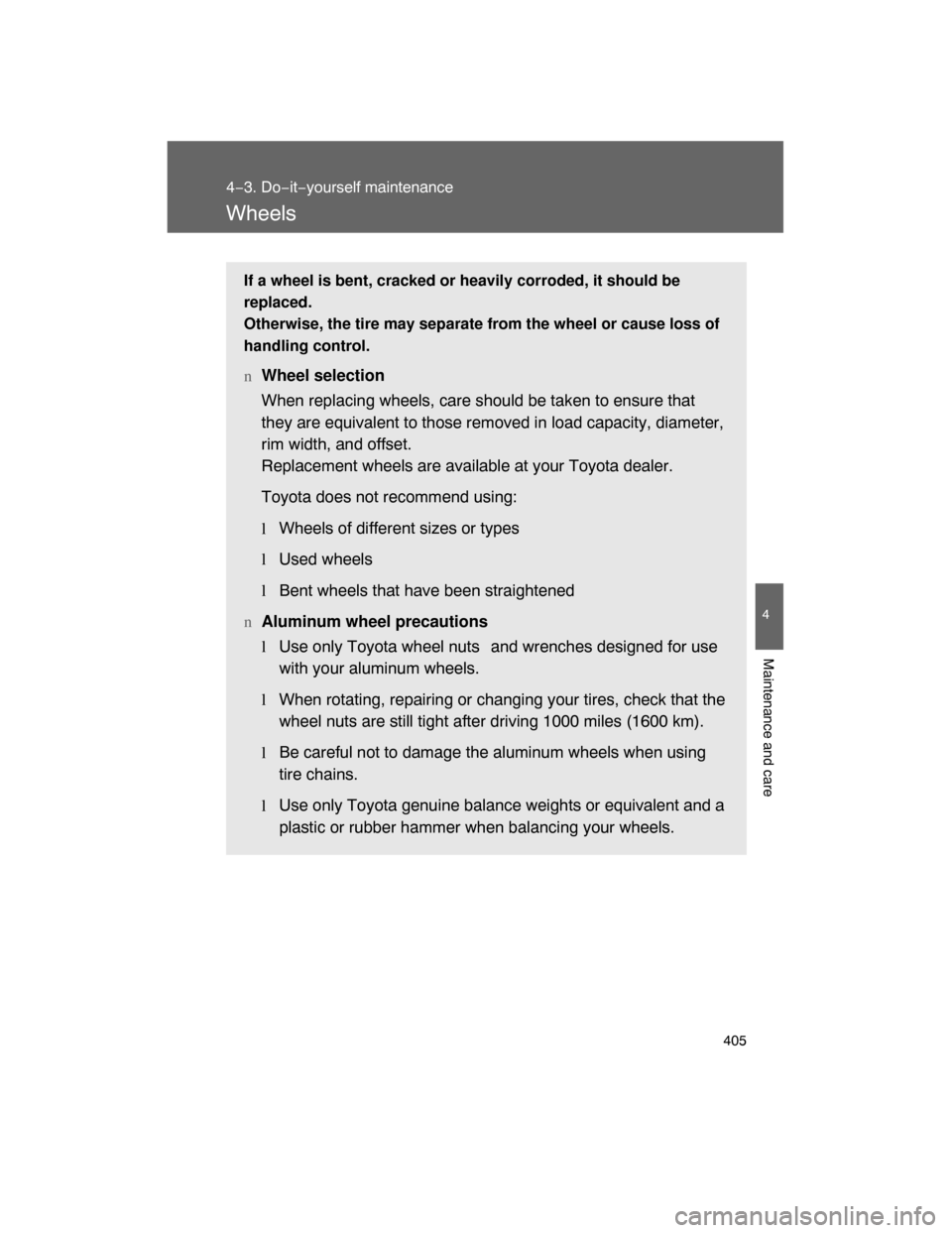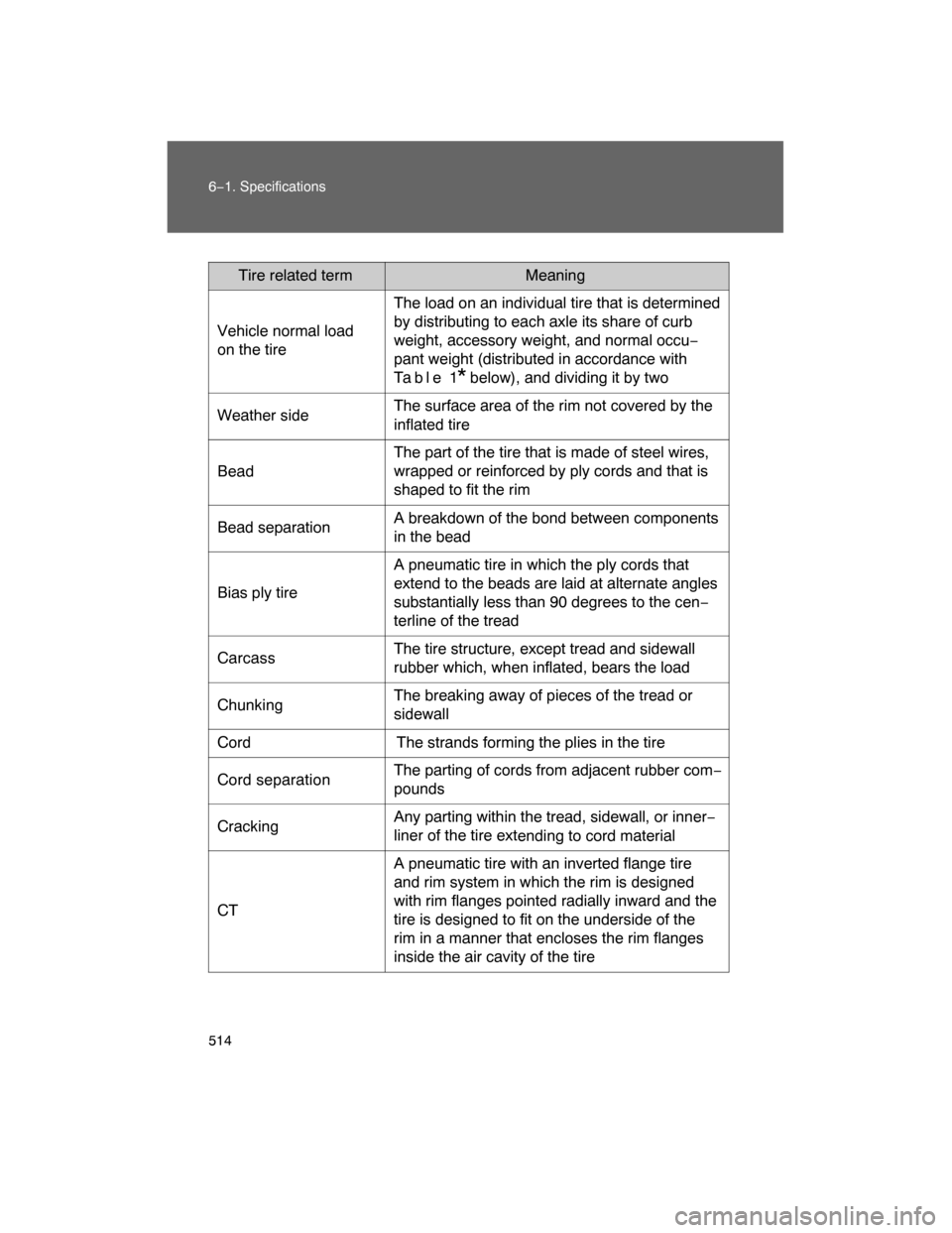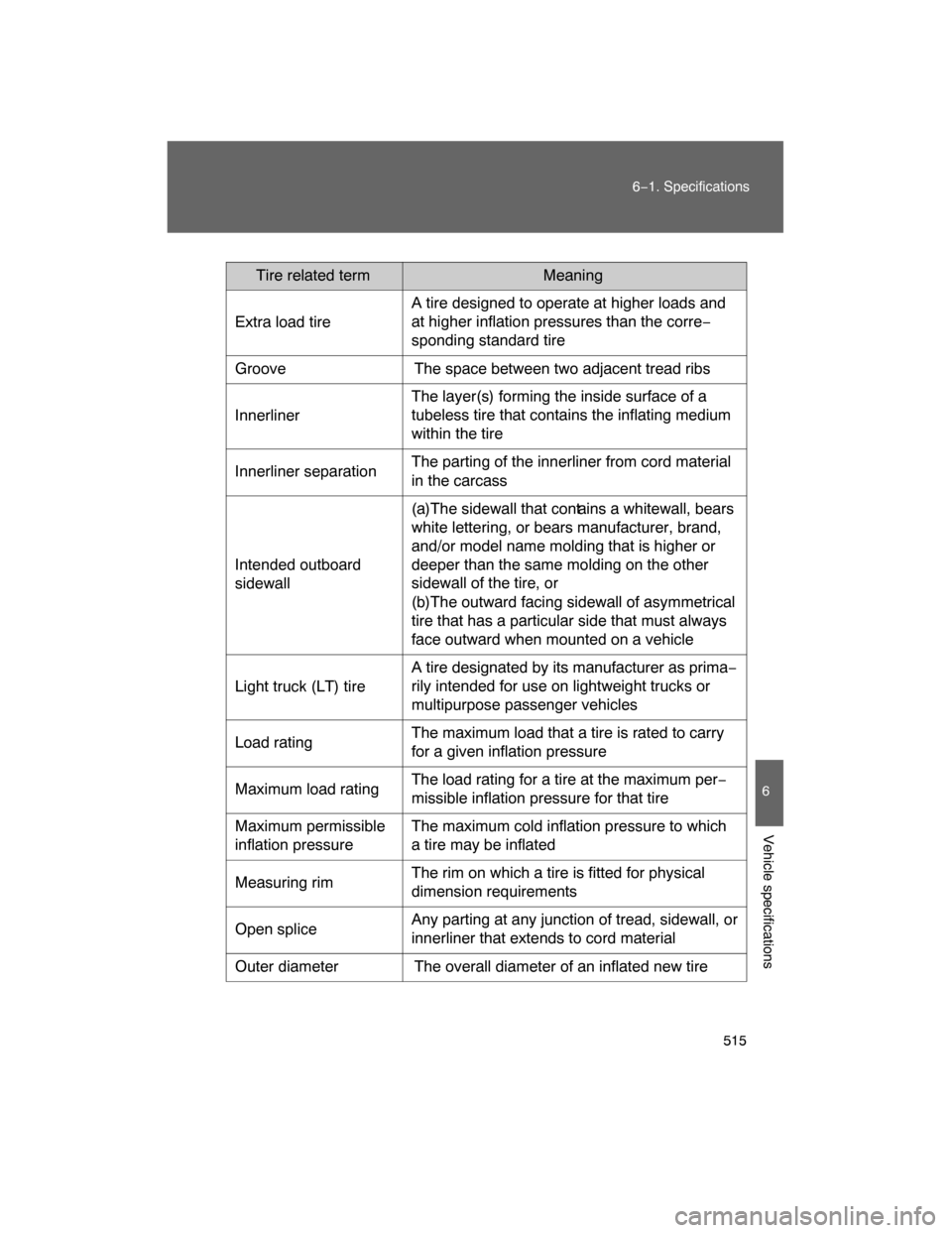Page 396 of 531
401
4−3. Do−it−yourself maintenance
4
Maintenance and care
Tire inflation pressure
nTire inflation pressure
The recommended cold tire inflation pressure and tire size is dis−
played on the tire and loading information label. (
P. 502)
TIRE SIZECOLD TIRE PRESSUREPXXX/XXRXX
PXXX/XXRXXXXXkPa,XXPSI
XXXkPa,XXPSI
XXXkPa,XXPSI
PXXX/XXRXXPXXX/XXRXX
PXXX/XXRXX
PXXX/XXRXXXXXkPa,XXPSI
FRONT
REAR
SPAREPNEUSDIMENSIONPRESSION
GONFLAGE A FROIDDEXXXkPa,XXPSI
XXXkPa,XXPSI AVA N TARRIERESECOURS
TIRE
SEE MANUAL
ADDITIONAL INFORMATIONFOR OWNER’S
AND LOADINGSEATINGTheand cargo should never exceed XXX XXXkg lbs.orcombined weight occupantsofCAPACITY TOTAL
FRONT
POUR
VOIR
LE DUMANUEL PROPRIETAIREDEPLUS AMPLES INFORMATIONS,
REARINFORMATIONINFORMATION
NOMBRE
Le
doit jamais etre a kg lb.ouXXX XXXsuperieur poids totaldes et du nechargementoccupantsDE PLACES ASSISESTOTAL X
AVA N T XARRIEREXSUR LES ET LEPNEUSCHARGEMENTXXX
ITY43C072
Page 398 of 531

403
4−3. Do−it−yourself maintenance
4
Maintenance and care
nEffects of incorrect tire inflation pressure
Driving with incorrect ti
re inflation pressure may result in the following:
lReduced fuel efficiency
lReduced driving comfort and tire life
lReduced safety
lDamage to the drive train
If a tire needs frequent re
filling, have it checked by your Toyota dealer.
nInstructions for checking tire inflation pressure
When checking tire inflation pressure, observe the following:
lCheck only when the tires are cold.
If your vehicle has been parked for at least 3 hours and has not been
driven for more than 1 mile or
1.5 km, you will get an accurate cold
tire inflation pressure reading.
lAlways use a tire pressure gauge.
The appearance of the tire can be mi
sleading. In addition, tire infla−
tion pressures that are even just a few pounds off can degrade ride
and handling.
lDo not bleed or reduce tire inflation pressure after driving. It is normal
for the tire inflation pressure to be higher after driving.
lNever exceed the vehicle capacity weight.
Passengers and luggage weight should be placed so that the vehicle
is balanced.
Page 400 of 531

405
4−3. Do−it−yourself maintenance
4
Maintenance and care
Wheels
If a wheel is bent, cracked or heavily corroded, it should be
replaced.
Otherwise, the tire may separate from the wheel or cause loss of
handling control.
nWheel selection
When replacing wheels, care should be taken to ensure that
they are equivalent to those removed in load capacity, diameter,
rim width, and offset.
Replacement wheels are available at your Toyota dealer.
Toyota does not recommend using:
lWheels of different sizes or types
lUsed wheels
l
Bent wheels that have been straightened
n
Aluminum wheel precautions
l
Use only Toyota wheel nuts and wrenches designed for use
with your aluminum wheels.
l
When rotating, repairing or changing your tires, check that the
wheel nuts are still tight after driving 1000 miles (1600 km).
lBe careful not to damage the aluminum wheels when using
tire chains.
lUse only Toyota genuine balance weights or equivalent and a
plastic or rubber hammer when balancing your wheels.
Page 487 of 531
494
6−1. Specifications
Maintenance data (fuel, oil level, etc.)
Dimensions and weight
*: Unladen vehicle
Overall length194.9 in. (4950 mm)
Overall width
77.6 in. (1970 mm)
Overall height
*74.0 in. (1880 mm)
Wheelbase
112.2 in. (2850 mm)
TreadFront64.6 in. (1640 mm)
Rear
64.4 in. (1635 mm)
Vehicle capacity weight
(Occupants + luggage)
1235 lb. (560 kg)
Towing capacity
(trailer weight + cargo weight)
8500 lb. (3856 kg)
Page 505 of 531

512 6−1. Specifications
Warning: The temperature grades for this tire are established for a
tire that is properly inflated and not overloaded.
Excessive speed, underinflation, or
excessive loading, either sepa−
rately or in combination, can cause heat buildup and possible tire fail−
ure.
Glossary of tire terminology
Tire related term Meaning
Cold tire inflation
pressureTire pressure when the vehicle has been
parked for three hours or more, or has not
been driven more than 1 mile or 1.5 km under
that condition
Maximum inflation
pressureThe maximum cold inflated pressure to which a
tire may be inflated, shown on the sidewall of
the tire
Recommended
inflation pressureCold tire inflation pressure recommended by a
manufacturer.
Accessory weightThe combined weight (in excess of those stan−
dard items which may be replaced) of trans−
mission, power steering, power brakes, power
windows, power seats, radio and heater, to the
extent that these items are available as factory−
installed equipment (whether installed or not)
Curb weightThe weight of a motor vehicle with standard
equipment, including the maximum capacity of
fuel, oil and coolant, and if so equipped, air
conditioning and additional weight optional
engine
Maximum loaded
vehicle weight
The sum of:
(a) Curb weight
(b) Accessory weight
(c) Vehicle capacity weight
(d) Production options weight
Page 506 of 531

513
6−1. Specifications
6
Vehicle specifications
Tire related term Meaning
Normal occupant
weight150 lb. (68 kg) times the number of occupants
specified in the second column of Table 1
* that
follows
Occupant distributionDistribution of occupants in a vehicle as speci−
fied in the third column of Table 1
* below
Production options
weightThe combined weight of installed regular pro−
duction options weighing over 5 lb. (2.3 kg) in
excess of the standard items which they
replace, not previously considered in curb
weight or accessory weight, including heavy
duty brakes, ride levelers, roof rack, heavy duty
battery, and special trim
RimA metal support for a tire or a tire and tube
assembly upon which the tire beads are seated
Rim diameter
(Wheel diameter)Nominal diameter of the bead seat
Rim size designation Rim diameter and width
Rim type designationThe industry manufacturer ’s designation for a
rim by style or code
Rim width Nominal distance between rim flanges
Vehicle capacity
weight (Total load
capacity)The rated cargo and luggage load plus 150 lb.
(68 kg) times the vehicle’s designated seating
capacity
Vehicle maximum load
on the tire
The load on an individual tire that is determined
by distributing to each axle its share of the
maximum loaded vehicle weight, and dividing
by two
Page 507 of 531

514 6−1. Specifications
Tire related term Meaning
Vehicle normal load
on the tireThe load on an individual tire that is determined
by distributing to each axle its share of curb
weight, accessory weight, and normal occu−
pant weight (distributed in accordance with
Table 1
* below), and dividing it by two
Weather sideThe surface area of the rim not covered by the
inflated tire
BeadThe part of the tire that is made of steel wires,
wrapped or reinforced by ply cords and that is
shaped to fit the rim
Bead separationA breakdown of the bond between components
in the bead
Bias ply tireA pneumatic tire in which the ply cords that
extend to the beads are laid at alternate angles
substantially less than 90 degrees to the cen−
terline of the tread
CarcassThe tire structure, except tread and sidewall
rubber which, when inflated, bears the load
ChunkingThe breaking away of pieces of the tread or
sidewall
Cord The strands forming the plies in the tire
Cord separationThe parting of cords from adjacent rubber com−
pounds
CrackingAny parting within the tread, sidewall, or inner−
liner of the tire ext
ending to cord material
CT
A pneumatic tire with an inverted flange tire
and rim system in which the rim is designed
with rim flanges pointed radially inward and the
tire is designed to fit on the underside of the
rim in a manner that encloses the rim flanges
inside the air cavity of the tire
Page 508 of 531

515
6−1. Specifications
6
Vehicle specifications
Tire related term Meaning
Extra load tireA tire designed to operate at higher loads and
at higher inflation pressures than the corre−
sponding standard tire
Groove The space between two adjacent tread ribs
InnerlinerThe layer(s) forming the inside surface of a
tubeless tire that contains the inflating medium
within the tire
Innerliner separationThe parting of the innerliner from cord material
in the carcass
Intended outboard
sidewall(a)The sidewall that contains a whitewall, bears
white lettering, or bears manufacturer, brand,
and/or model name molding that is higher or
deeper than the same molding on the other
sidewall of the tire, or
(b)The outward facing sidewall of asymmetrical
tire that has a particular side that must always
face outward when mounted on a vehicle
Light truck (LT) tireA tire designated by its manufacturer as prima−
rily intended for use on lightweight trucks or
multipurpose passenger vehicles
Load ratingThe maximum load that a tire is rated to carry
for a given inflation pressure
Maximum load ratingThe load rating for a tire at the maximum per−
missible inflation pressure for that tire
Maximum permissible
inflation pressureThe maximum cold inflation pressure to which
a tire may be inflated
Measuring rimThe rim on which a tire is fitted for physical
dimension requirements
Open spliceAny parting at any junction of tread, sidewall, or
innerliner that extends to cord material
Outer diameter The overall diameter of an inflated new tire